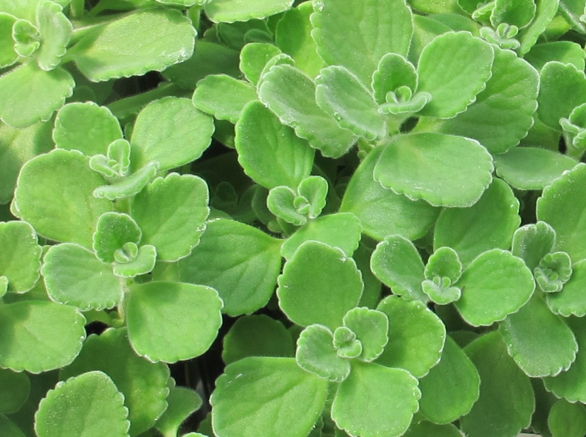Cuban Oregano genus Plectranthus amboinicus
Cuban Oregano genus Plectranthus amboinicus
I’m not from Cuba, but India. I’m not oregano, but I am a succulent herb. My nicknames include Indian borage, Mexican mint, Húng chanh, Broadleaf thyme, Spanish thyme, Caribbean oregano, and French thyme. I give off a strong smell similar to thyme, oregano or rosemary with a touch of lemon. If you rub my leaves on your skin, it will help keep mosquitoes away. What plant am I? I am Cuban oregano Plectranthus amboinicus.
Cuban oregano has fragrant and fuzzy leaves. The leaves are grayish green, finely haired with saw-toothed edges. I’ve read they produce spiked purple flowers, but mine have never flowered. Though it can’t survive outdoors in Ohio’s harsh winters, it makes a great houseplant. I purchased my mother plant in 2013 at the Kent Farmer’s Market. Since then I have propagated it least 10-12 times. It’s easy to propagate with just a stem cutting – you don’t even need root hormones. I prefer to use clay pots for my plantings.
They tend to get a bit leggy (like me) so make sure they don’t have to reach too far for some sunshine. Since they like to trail, they would look nice in hanging baskets. Like with any herb, gently rub the leaves between your fingers to release the oils and enjoy the full extent of its unique fragrance.
Smarty Plants Fun Facts
Cuban oregano is in the family Lamiaceae (mint family)
Well-drained soil, occasional irrigation, sunny south window
10”-18” tall and tends to spread
The More You Grow
Did you know that Cuban oregano has nutritional value? It contains vitamin C, vitamin A, and omega 6. It also has anti-inflammatory properties. Cuban oregano contains properties that can actually neutralize the heat in hot peppers.
Did you know that some people call it the Vicks plant because of its menthol aroma, which is similar to Vick’s salve? The leaves can be chewed or crushed to help clear blocked nasal passages. The crushed leaves can be used to help burns, sores, eczema or insect bites. Tea made from the leaves is used around the world to treat bronchitis, asthma, colds, coughs, indigestion, stomach cramps, insomnia, and headache pain. For Ayurvedic practices in India and Indonesia, it is prescribed as an anti-inflammatory, and used to induce sweating to relieve a fever.
In kitchens in Cuba, India, Malaysia, and the Philippines, Cuban oregano is used as a substitute for traditional Italian oregano or thyme in the local cuisines. It pairs well with meat and fish. In poultry stuffing, beef, lamb, and wild game dishes, use sparingly because it can be overpowering. In India, it is even used as a flavoring in beers and wines. Since it is used as a flavoring ingredient in Cuban Black Bean Soup, maybe that’s where it got its name.
It doesn’t dry well, but you can store unwashed Cuban oregano in a plastic bag in the refrigerator for up to a week.
Some folklore associated with this plant, suggests there is evidence that Brazilian people and specifically African immigrants to Brazil used it in rituals. It was burned as an offering or to consecrate places of worship. It was used like sage for protection or as a cleansing magic. It was thought to be a sign that fairies have blessed a place. Others wore it as a sachet to encourage psychic sensitivity.
Less mystical and more practical, Cuban oregano can be used to keep mosquitoes away. Just rub the leaves on the skin as a natural insect repellent. Personally, I’m concerned with the harmful chemicals in mainstream bug sprays, so I’m always looking for a safer alternative. Watch out bugs, Cuban oregano is here ward off pesky insects!


